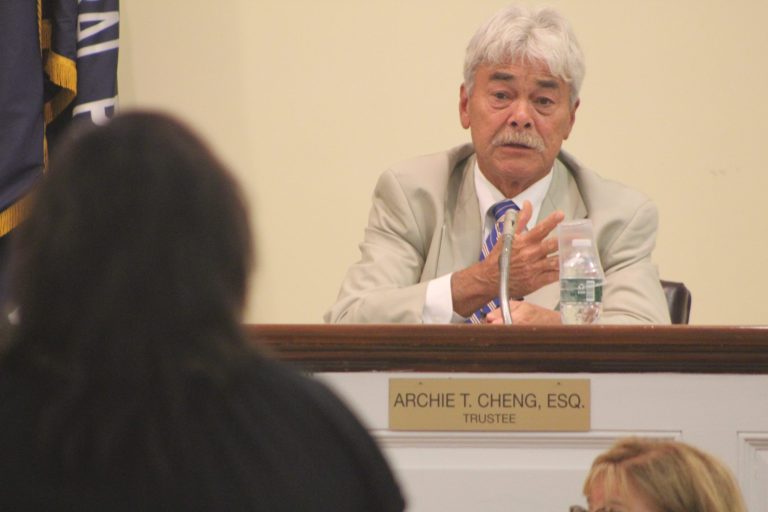
Floral Park residents vented their frustration over construction on the Long Island Rail Road’s Hempstead branch to the village Board of Trustees on Tuesday night.
As part of the commuter rail’s expansion project, crews will be installing switches to move trains from track to track more easily. But residents and trustees griped that crews have been working for longer than originally thought.
“The daily 3TC workers introduced themselves and were very friendly and considerate as best as they could under the circumstances,” Gina Martinez, who lives adjacent to the construction site, said, referring to the joint-venture firm responsible for the construction. “3TC community outreach reps however have been deceitful from day one in communicating their work plan and how long it would last to the village and to the residents.”
Beginning July 24, for four consecutive weekends, work will be done on the Hempstead branch of the railroad from Friday night through Monday morning.
The work is part of the Metropolitan Transportation Authority’s LIRR Expansion Project, which MTA officials say has cut down on noise by reducing train horns, removing railroad crossing bells and installing retaining and sound attenuation walls along a crucial corridor from Floral Park to Hicksville.
“Since 2016, the project team has held hundreds of public meetings to discuss the scope of project elements and has met with Village Boards, property owners’ associations, school districts, civic associations, business owners, residents, and other stakeholder groups,” MTA spokesperson Meredith Daniels said in a statement to Blank Slate Media. “Lookaheads and eblasts have advised the community in advance of work. The project maintains a 24/7 community hotline, dedicated community ambassadors, and a quarterly scorecard program.”
Trustee Archie Cheng, who is the village’s liaison to the Metropolitan Transportation Authority and LIRR, received communication from construction crews earlier that day on the next phase of work.
Previously, trucks and equipment were being brought to the railroad tracks via Tunnel Street. The village then negotiated to find an alternate route, though it may not mean less noise for residents.
“I think some of their solutions, quite honestly, are worse than what we had already thought was going to happen,” Cheng said.
All supporting workshop equipment will enter through the county basin across from the Department of Public Works on Stewart Street, according to a notice that Cheng read at the meeting.
Tunnel Street will no longer be used as an exit. Instead, trucks will be backed into the basin starting at 2 a.m. from Stewart Street, and will exit the same way they came in.
“Here’s the flip side to this,” Cheng said. Now, trucks will back in across the New Hyde Park DPW yard, reversing from that location all the way back to Tunnel Street. This will happen with their backup alarms, which are required by law to be on the whole way.
“Those backup alarms will be heard not only from Tunnel Street, but all along Cisney (Avenue), all along Magnolia (Avenue),” Cheng said. “So, I don’t know if we pulled off the right request.”
Though he said the village won this battle, limiting access via Tunnel Street except for light pickup trucks, Cheng pointed out there is nothing that can be done regarding construction that happens on the LIRR’s right of way.
“There’s going to be lights all night long,” Cheng said. “There is going to be noise which they describe as moderate to loud.”
Speaking to the board during open time, residents noted that the LIRR’s third track project went through several health and environmental studies but said no such reports were authored on the Hempstead line construction.
“I don’t think they can do what they’re doing,” Cheng said. “This village could not afford challenging the MTA, the Long Island Rail Road, for not following through the EIS [Environmental Impact Statement] process.”
Since it’s nearly finished, Cheng said the best way to move forward would be to complete the project as quickly as possible by making a plan for construction.
“Everybody’s just as frustrated,” Cheng said. “We are trying the best we can to get something done. That doesn’t mean we always win.”






